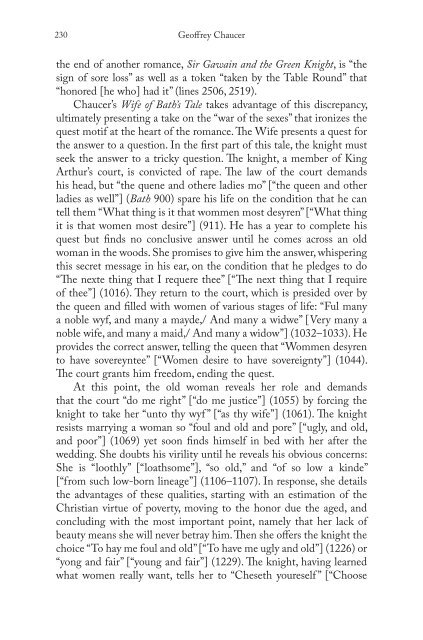Blooms Literary Themes - THE TRICKSTER.pdf - ymerleksi - home
Blooms Literary Themes - THE TRICKSTER.pdf - ymerleksi - home
Blooms Literary Themes - THE TRICKSTER.pdf - ymerleksi - home
Create successful ePaper yourself
Turn your PDF publications into a flip-book with our unique Google optimized e-Paper software.
230<br />
Geoff rey Chaucer<br />
the end of another romance, Sir Gawain and the Green Knight, is “the<br />
sign of sore loss” as well as a token “taken by the Table Round” that<br />
“honored [he who] had it” (lines 2506, 2519).<br />
Chaucer’s Wife of Bath’s Tale takes advantage of this discrepancy,<br />
ultimately presenting a take on the “war of the sexes” that ironizes the<br />
quest motif at the heart of the romance. Th e Wife presents a quest for<br />
the answer to a question. In the fi rst part of this tale, the knight must<br />
seek the answer to a tricky question. Th e knight, a member of King<br />
Arthur’s court, is convicted of rape. Th e law of the court demands<br />
his head, but “the quene and othere ladies mo” [“the queen and other<br />
ladies as well”] (Bath 900) spare his life on the condition that he can<br />
tell them “What thing is it that wommen most desyren” [“What thing<br />
it is that women most desire”] (911). He has a year to complete his<br />
quest but fi nds no conclusive answer until he comes across an old<br />
woman in the woods. She promises to give him the answer, whispering<br />
this secret message in his ear, on the condition that he pledges to do<br />
“Th e nexte thing that I requere thee” [“Th e next thing that I require<br />
of thee”] (1016). Th ey return to the court, which is presided over by<br />
the queen and fi lled with women of various stages of life: “Ful many<br />
a noble wyf, and many a mayde,/ And many a widwe” [Very many a<br />
noble wife, and many a maid,/ And many a widow”] (1032–1033). He<br />
provides the correct answer, telling the queen that “Wommen desyren<br />
to have sovereyntee” [“Women desire to have sovereignty”] (1044).<br />
Th e court grants him freedom, ending the quest.<br />
At this point, the old woman reveals her role and demands<br />
that the court “do me right” [“do me justice”] (1055) by forcing the<br />
knight to take her “unto thy wyf ” [“as thy wife”] (1061). Th e knight<br />
resists marrying a woman so “foul and old and pore” [“ugly, and old,<br />
and poor”] (1069) yet soon fi nds himself in bed with her after the<br />
wedding. She doubts his virility until he reveals his obvious concerns:<br />
She is “loothly” [“loathsome”], “so old,” and “of so low a kinde”<br />
[“from such low-born lineage”] (1106–1107). In response, she details<br />
the advantages of these qualities, starting with an estimation of the<br />
Christian virtue of poverty, moving to the honor due the aged, and<br />
concluding with the most important point, namely that her lack of<br />
beauty means she will never betray him. Th en she off ers the knight the<br />
choice “To hay me foul and old” [“To have me ugly and old”] (1226) or<br />
“yong and fair” [“young and fair”] (1229). Th e knight, having learned<br />
what women really want, tells her to “Cheseth youreself ” [“Choose

















